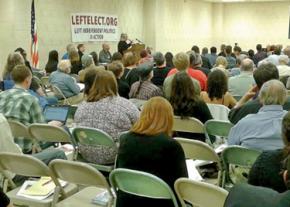Building something to vote for
, and report from a conference of activists discussing strategies for building independent, left-wing electoral alternatives.
ALMOST 200 people from across the U.S. came together at the "Future of Left and Independent Politics" conference in Chicago on May 2-3 to discuss and debate the prospects for building an electoral challenge to the left of the Democratic Party.
Veterans of left and independent political campaigns--including Green Party presidential and vice presidential candidates Jill Stein and Rosa Clemente, Mayor Gayle McLaughlin of the Richmond (California) Progressive Alliance (RPA), Chicago Socialist Campaign aldermanic candidate Jorge Mújica, Chicago labor aldermanic candidate Tim Meegan and many others--presented on a number of important topics.
While the bulk of the conference was composed of veterans of many campaigns and left political movements, a core of around 25 younger activists attended from as far away as New Jersey and Tennessee on the strength of online promotion for the conference. Conference organizers noted that the attendance was double what they anticipated, but also agreed that future conferences should make special outreach to assure a more racially and age-diverse attendance.

The conference was held only a few days after Vermont Sen. Bernie Sanders announced his candidacy for the Democratic Party presidential nomination. Though nominally an independent, Sanders' candidacy within the Democratic Party was clearly a challenge to the call of the conference that proposed a "gathering of candidates, individuals and organizations committed to a left political alternative in opposition to the two-party system of corporate capitalist rule."
Some activists, including members of the Vermont Progressive Party, distributed a personal letter from Sanders to the conference. The letter announced his presidential campaign, justified running inside the Democratic primaries, and asked for support. When one Green Party member stood up and asked, "How many people here will support Bernie as a Democrat?" about 15 people raised their hands.
Bruce Dixon, co-chair of the Georgia Green Party, expressed the dominant sense of the conference. In his presentation at the evening public meeting on "Elections, Labor and Social Movements: Why We Need Independent Political Campaigns," Dixon explained that he had begun his political activity as a Black Panther and had worked for Black Democrats in Chicago in 1970s and 1980s, like former Mayor Harold Washington, but that his experience in Jesse Jackson's Rainbow Coalition changed him from what he described as being a "Democrat in denial."
Dixon argued that Sanders would do exactly what Jackson and Dennis Kucinich had done, which is to act as the "the left sheepdog for the Democratic Party--he'll guard the flock and drive anyone who tries to leave back into line."
Amisha Patel, executive director of the Chicago-based Grassroots Collaborative, disagreed with Dixon's approach, arguing that there was nothing inherently positive about breaking with the Democratic Party. She suggested that it could be even more radical to run inside the Democratic Party if a candidate raised issues critical to the community.
WHILE THE vast majority of participants at the conference disagreed with her about this, the discussion did underscore the reality that only a minority of organizers and leftists today see challenging the institution of the Democratic Party as realistic or any sort of short-term priority.
Socialist Alternative member Kshama Sawant, now a member of the Seattle City Council, addressed the conference by video and also urged activists to build a left alternative to the Democrats that draws its base from social struggles like Black Lives Matter and the Fight for 15. Supporting Sawant's re-election in the fall will be a major focus for activists who attended the conference.
Topics discussed in the plenaries and workshops ranged from historical discussions of previous independent political campaigns to skills workshops on fundraising. The conference discussed how to relate independent politics to labor issues such as the Fight for 15, and to the Black Lives Matter (BLM) movement.
In general, participants recognized that we have a difficult task in developing an electoral front on these issues because of the Democrats' domination of the unions on the one hand and the complexity of relating existing independent political forces to the dynamics of movements like BLM. All in all, this was a sober, but hopeful discussion.
The conference--initiated by a coalition of organizations including Solidarity, the International Socialist Organization and Socialist Alternative, along with members of RPA, several Green Party state organizations and the Peace and Freedom Party--provided a model for collaboration among different organizations on the left.
On Sunday, the conference voted to continue the planning committee and mandate it to send a report on the conference to attendees, to maintain its website and publicize independent campaigns on it, and to begin a discussion about the potential for a follow-up conference in the spring of 2016.
There is a range of opinions about the goals of a future conference--from those who believe it could make a major impact on the 2016 elections, to those who think it should primarily focus on bringing local efforts into dialogue, to those who believe it is too early to tell what the impact of Sanders' entry into the race, the direction of BLM and other contingent developments will be.
The conference pointed to a layer of people looking to the left of the Democrats, while exposing the relative weakness of the forces already committed to organizing a break. If the conference set itself modest goals to begin with, it met those goals and marked a useful example of how various groups on the left can work together when there is a clear, common goal.


